Industri perlombongan adalah proses yang kompleks dan agak berisiko. Pengendalian peralatan perlombongan yang efektif dan selamat bukan sahaja keperluan prosedural, tetapi merupakan sebahagian penting dalam perlindungan kakitangan, kesinambungan proses operasi, dan persekitaran kerja yang efektif. Panduan ini akan merangkumi tingkah laku dan garis panduan penting yang perlu dipatuhi oleh semua pihak yang terlibat dalam pengendalian dan penyelenggaraan jentera berat di permukaan dan bawah tanah. Garis panduan ini akan membantu dalam membangunkan budaya keselamatan yang kukuh supaya semua pekerja dapat pulang ke rumah tanpa sebarang kecederaan selepas setiap kemasan.
Pemeriksaan Peralatan Secara Menyeluruh
Peringkat pemeriksaan dan persediaan menyeluruh perlu dilakukan sebelum mana-mana peralatan dihidupkan. Ini merupakan langkah asas untuk mengenal pasti masalah yang berkemungkinan menyebabkan kerosakan atau kemalangan semasa operasi.
Pemeriksaan visual dan fungsian mesti dilakukan secara teliti pada awal setiap peralihan. Seorang operator perlu memeriksa sebarang tanda kerosakan yang boleh dilihat, contohnya retakan pada komponen struktur, kebocoran hidraulik, atau tayar dan trek yang berada dalam keadaan buruk. Sebarang ciri keselamatan seperti lampu, hon, amaran undur dan sistem penutupan kecemasan juga perlu diperiksa untuk memastikan berada dalam keadaan berfungsi yang optimum. Jangan menganggap operator sebelumnya meninggalkan peralatan dalam keadaan baik; pemeriksaan peribadi tidak boleh diabaikan sebagai sebahagian daripada tugas.
Memahami Persekitaran Kerja
Adalah penting juga untuk mengetahui keadaan persekitaran kerja. Jalankan tinjauan kestabilan kawasan, bahaya dari atas, dan pencahayaan. Komunikasi yang efisien dengan kakitangan di darat adalah perlu untuk membangunkan laluan pergerakan yang selamat serta menentukan sebarang kawasan yang mengandungi ancaman khusus. Pertimbangkan aktiviti harian dan pastikan ia boleh dilaksanakan menggunakan peralatan serta langkah-langkah keselamatan yang ditetapkan oleh tapak.
Amalan Pengendalian yang Selamat dan Mematuhi Had Operasi
Setelah semua pemeriksaan selesai dilakukan dan kawasan kerja sedia, pengendali perlu berwaspada dalam menjalankan tugas tanpa mengorbankan keselamatan. Personel yang paling berpengalaman pun turut terdedah kepada punca utama kemalangan, iaitu perasaan terlalu yakin (complacency).
Semua peralatan lombong dikonfigurasikan dengan had operasi tertentu dari segi kapasiti beban, kelajuan dan kecerunan. Apabila had-had ini dilanggar, risiko krenung, perlanggaran dan kegagalan mekanikal menjadi sangat tinggi. Pengendali sentiasa perlu memantau panel instrumen untuk memeriksa amaran dan memastikan mereka tidak mengambil jalan pintas yang boleh menjejaskan parameter keselamatan yang telah direkabentuk. Pergerakan yang cepat tetapi terkawal sentiasa lebih diutamakan berbanding pergerakan yang tergesa-gesa.
Mengekalkan Komunikasi dan Kesedaran yang Jelas
Alam sekitar perlombongan adalah tidak stabil dan biasanya terdapat pelbagai peralatan serta personel yang berdekatan. Hubungan berterusan dengan kelulusan isyarat yang diluluskan, radio, atau sistem kenderaan-ke-kenderaan adalah penting. Sentiasa perlu bagi pengendali sedar akan alam sekitar mereka, menggunakan cermin dan kamera secara berkesan dan jangan pernah menganggap bahawa mereka boleh dilihat atau didengar. Keletihan juga merupakan salah satu aspek paling kritikal yang perlu dikurangkan dengan mengambil rehat secara berkala untuk mengekalkan kesedaran situasi pada tahap tinggi sepanjang tugas yang panjang.
Pasca Operasi dan Penyelenggaraan
Fakta bahawa peralatan telah dimatikan tidak bermaksud keselamatan telah dijamin. Proses selepas operasi yang sesuai akan menjadikan peralatan tersedia untuk pengguna seterusnya dan bagi mengesan masalah yang timbul sebelum ia menjadi masalah besar.
Pemberhentian yang Betul dan Pelaporan
Patuhi proses penutupan piawai untuk mengunci peralatan. Ini melibatkan pengurangan keamatan alat kelengkapan ke tanah, penggunaan brek pegun dan mematikan suis enjin. Pengendali hendaklah mencatatkan sebarang kerosakan, bunyi yang tidak biasa, dan masalah prestasi yang dialaminya semasa tugas dalam buku log penyelenggaraan sebelum meninggalkan kabin. Pelaporan tepat seperti ini merupakan benteng utama dalam penyelenggaraan ramalan.
Peranan Penyelenggaraan Berjadual
Pengendali akan menjalankan pemeriksaan rutin setiap hari, tetapi penyelenggaraan berkala dilakukan oleh mekanik yang berlesen secara berkala mengikut garis panduan penyelenggaraan ketat yang diberikan oleh pengilang. Ini termasuk pertukaran minyak, penggantian penapis, pemeriksaan brek, dan integriti struktur. Budaya penyelenggaraan proaktif membantu mengelakkan kegagalan mengejut pada peralatan yang boleh menyebabkan keadaan berbahaya dan tempoh tidak produktif yang mahal.

 EN
EN
 AR
AR
 CS
CS
 DA
DA
 NL
NL
 FI
FI
 FR
FR
 DE
DE
 EL
EL
 IT
IT
 JA
JA
 PL
PL
 PT
PT
 RU
RU
 ES
ES
 SV
SV
 TL
TL
 ID
ID
 LT
LT
 UK
UK
 TR
TR
 FA
FA
 AF
AF
 MS
MS
 GA
GA
 BE
BE
 HY
HY
 KA
KA
 EO
EO
 LA
LA
 SO
SO
 ZU
ZU
 KK
KK
 TG
TG
 UZ
UZ
 KY
KY
 XH
XH

